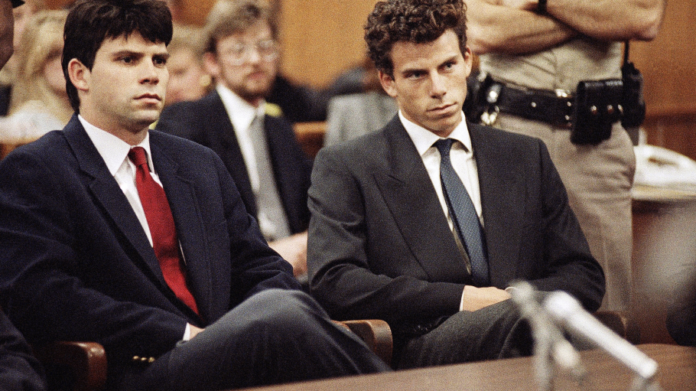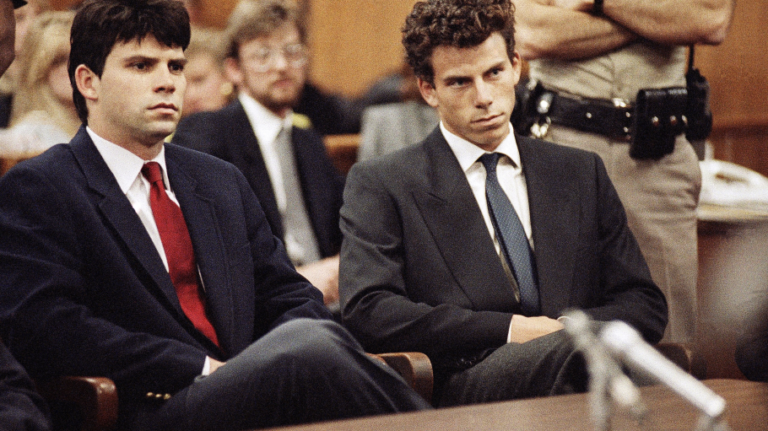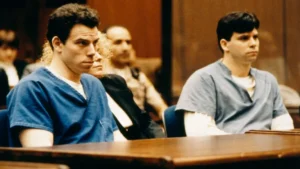

Lyle, left, and Erik Menendez sit in Beverly Hills Municipal Court during their trial for the 1989 murder of their parents, Kitty and José Menendez. Nick Ut/AP
Table of Contents
ToggleLegal Analysis of the Menendez Brothers Case
The Menendez brothers’ case is a landmark in legal history, capturing widespread media attention and sparking debates on legal principles, mental health, and the criminal justice system’s effectiveness. This analysis aims to dissect the case from various angles, including self-defense, media influence, mental health, and familial dynamics, to understand its complexities and implications for future legal proceedings.
Legal Principles of Self-Defense and Abuse as a Defense
Definition and Elements of Self-Defense
Self-defense is a legal doctrine that justifies the use of force by one individual against another when faced with an imminent threat of harm. The core elements include:
- Imminence: The threat must be immediate.
- Proportionality: The response must be proportionate to the threat.
- Necessity: The use of force must be necessary to prevent harm.
Application in the Menendez Case
The defense argued that Lyle and Erik Menendez killed their parents out of fear for their lives after years of severe physical and emotional abuse. The argument hinged on the claim that the brothers believed they were in imminent danger, even without an immediate threat at the moment of the killings.
Abuse as a Defense Strategy
The defense introduced evidence of long-term abuse to justify the brothers’ belief in imminent danger, thus invoking the self-defense principle. This strategy shifts the focus from the act of killing to the psychological state of the defendants.
Comparisons with Other High-Profile Cases
Comparing the Menendez case to other high-profile cases, such as the trial of Lorena Bobbitt, who also claimed prolonged abuse, helps in understanding how courts interpret self-defense claims linked to chronic abuse.

Role of Media in Legal Proceedings
Impact on Public Perception and Trial Outcomes
The Menendez case received extensive media coverage, influencing public opinion and creating a complex trial environment. Sensational reporting can shape public perception, creating biases that may extend to jury members.
Media Influence on Jury Decisions
Studies have shown that media coverage can impact juror impartiality, making it difficult to ensure a fair trial. The Menendez brothers’ case exemplifies this challenge, as media narratives often overshadow factual evidence.
Managing Media Influence
Strategies such as gag orders, jury sequestration, and careful jury selection processes are often employed in high-profile cases to mitigate media influence. However, the effectiveness of these measures remains debatable.
Mental Health and Trauma in Criminal Defense
Importance of Mental Health Evaluations
Mental health assessments can be crucial in understanding a defendant’s actions and culpability. In the Menendez case, evaluations highlighted the psychological impact of prolonged abuse on the brothers.
Impact on Culpability
The defense argued that the brothers’ mental state, shaped by years of trauma, diminished their culpability. This perspective raises questions about the extent to which mental health should influence legal responsibility.
Presenting Trauma as a Defense
Introducing evidence of trauma can humanize defendants and provide context for their actions. However, it also challenges traditional interpretations of self-defense and culpability.
Effectiveness of the Criminal Justice System
Handling of the Menendez Case
The Menendez trial exposed several weaknesses in the criminal justice system, including difficulties dealing with complex family dynamics and media influence.
Fairness and Effectiveness of the Trial
Assessing the fairness of the Menendez trial involves examining whether the proceedings allowed for an impartial evaluation of evidence and whether the sentences were just.
Recommendations for Improvement
To better handle similar cases in the future, recommendations include:
- Enhanced training for legal professionals on trauma and mental health issues.
- Stricter regulations on media coverage of ongoing trials.
- More robust support systems for juries in high-profile cases.
The Menendez brothers’ case underscores the intricate interplay between legal principles, media influence, mental health, and the criminal justice system. By analyzing these factors, we gain valuable insights into improving legal proceedings and ensuring justice in complex cases involving familial abuse and trauma. Future legal reforms should aim to balance the need for public transparency with the imperative of fair, unbiased trials.
Join our newsletter or visit our website to learn more about how these elements can shape legal outcomes and stay informed about potential reforms.
Erik (left) and Lyle Menendez, pictured during their trial in Los Angeles in March 1994


